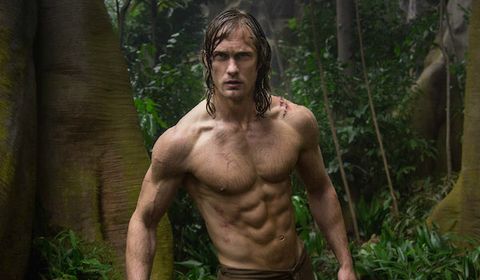Eight years have passed since John Clayton III (Alexander Skarsgard), aka Lord Greystoke -- and also known around the globe as Tarzan -- last set foot in the Congo as The Legend of Tarzan opens. Though raised in the wild by the same animals that helped kill his parents, Clayton has retreated to London, where he and his wife, Jane (Margot Robbie), live like aristocrats in Greystoke Manor. But Tarzan needs to return, and upon reuniting with former African tribesman they used to consider family, John Clayton and Jane are greeted with the warmest, "Welcome home!"
The same sentiment can be levied at Tarzan, the cinematic icon and theatrical mainstay who is back "home" on a theater screen for the first time in years, and proves that his adventures really fit the dimension of the largest screens possible, when placed in the capable hands of a storyteller like David Yates. The Legend of Tarzan, for the most part, is a romantic, exotic, dramatic, bold and exciting revitalization of the Tarzan story, steeped heavily in the lore created by novelist Edgar Rice Burroughs, but retrofitted for a modern audience. That's not to say there's anything contemporary about The Legend of Tarzan. Quiet the opposite, and it's the movie's inherent, authentic Old Hollywood feel -- enhanced by gorgeous cinematography and exquisite location shooting -- that makes a trip to the theater worth the time and effort.
For the most part. There are flaws. I'll touch on them in a second, for they can not be ignored.
The bulk of The Legend of Tarzan hums like a well-oiled machine. We start the film in the presence of the villain (and yes, the casting of Christoph Waltz as Tarzan's sinister antagonist is, by itself, cliché but it's hard to argue when he's so effective at being a conniving foe). Leon Rom (Waltz) has been sent to the Congo by King Leopold to retrieve a trio of precious diamonds from Chief Mbonga (Djimon Hounsou). In return, Rom makes a promise. He'll deliver Tarzan to Mbonga... who needs the one-time vine swinger for reasons I'll leave to be discovered.
Back in London, Lord Greystoke (Skarsgard) is told of an invitation to the Congo by King Leopold, which the Brits view as a valuable political opportunity. Greystoke passes -- he doesn't miss the Congo in the least, and is content with his new life with Jane (Robbie). But an American ambassador (Samuel L. Jackson) piques Tarzan's interest with an interesting side plot offer involving a slavery-ring scandal in the hero's native, and so we're off to Africa, and the vast visual palette that lends to Yates and his team.
Everything about The Legend of Tarzan looks fantastic, from the period detail of the London scenes to the breathtaking African scenery that backdrops the adventure from the minute Tarzan and Jane return home. And yes, when I say "everything," I mainly mean the cast. Based on the gasps from our preview audience, Alexander Skarsgard is -- ahem -- built for this role. It says a lot that in scenes where Tarzan has to fight CGI gorillas twice his size to re-establish his dominance, I found the match to be quite believable (and the special effects very impressive... until the end -- almost there, I promise).
David Yates, who learned how to juggle numerous moving parts while directing the last few chapters of the Harry Potter saga, understands balance. There's just enough romance between Tarzan and Jane to keep the love story ignited; there's just enough comic relief by Samuel L. Jackson to break the tension; there's just enough "origin story," told via flashbacks; there's just enough mustache twirling by Waltz to remind us to hiss at the antagonist; and there's just enough exaggerated action to keep us invested in the film's central rescue mission. If anyone's shortchanged here, it's Robbie, who's Jane becomes inconsequential early on in the movie, once she's abducted by Rom. From that point on, she's beautiful bait, a gorgeous carrot dangling on a stick that allows the movie to move forward, and Robbie deserves more than that.
I take it back. Jane's portrayal, and lack of proper motivation, isn't the film's worst misstep. It's the finale -- a rushed affair that contradicts the deliberate pace of the opening 95 minutes and includes a laughably embarrassing "stampede" effect that never should have been allowed in theaters. It looks unfinished, and terrible, and deep down, I have to believe that Yates knows how inadequate the sequence looks, and merely ran out of time. That's the only excuse I can conjure. You'll still be laughing at the stampede when The Legend of Tarzan concludes, which is a shame. All of the stupid is contained to the final 15 minutes of Tarzan. Try to forget them, because the rest is entertaining enough.

Sean O’Connell is a journalist and CinemaBlend’s Managing Editor. Having been with the site since 2011, Sean interviewed myriad directors, actors and producers, and created ReelBlend, which he proudly cohosts with Jake Hamilton and Kevin McCarthy. And he's the author of RELEASE THE SNYDER CUT, the Spider-Man history book WITH GREAT POWER, and an upcoming book about Bruce Willis.
Most Popular



